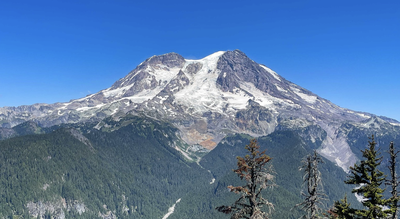
Trip
Day Hike - Gobblers Knob
Gobblers Knob Fire Lookout is one of the 5 lookouts of Mt. Rainier. On the west park boundary, access begins from the Westside Road eventually leading to Lake George and stunning views of Rainier at Gobblers Knob.
- Wed, Sep 13, 2023
- Tacoma Hiking & Backpacking Committee
- Day Hiking
- Adults
- Strenuous
- Moderate
- Mileage: 13.0 mi
- Elevation Gain: 2,850 ft
- Pace: 2 mph
- FULL (5 capacity)
- FULL (2 capacity)
- Cancellation & Refund Policy
7:00 am Eatonville Visitor Center: All will meet and greet at the Eatonville Visitor Center 132 Mashel Ave N. Eatonville, WA 98328, gear shift then caravan to the trailhead. There is limited cell service at the Westside Road to Gobblers Knob Fire Lookout.
***PARK PASS: All vehicles continuing to the park, must have an America the Beautiful pass or military or senior pass; you may be asked for your photo ID so have it handy.
This hike starts as a shaded gravel uphill walk becoming a gradual hike along the Tahoma Creek. on the Westside Road. Once reaching the trailhead, the trail heads gently to Lake George. Just beyond the trail becomes exposed with more switchbacks and elevation gains. Fantastic views of Mt. St. Helens, Goat Lake below in the distance and eventually Rainier at the fire lookout, it is a beautiful and peaceful hike great for fall colors.
PLEASE NOTE: The limited water source this time of year and all participants will need to carry at least 2L of water and/or filter for Lake George. Participants should have had successfully day hiked a 2500' gain with at least 8-10 miles within the last few weeks.
When we reach the fire lookout, we will take a longer break for lunch and we might decide to hike over to the Kautz Memorial. We should be back to the cars around 4 pm at the latest if we do this side trip up the trail.
GEAR: Please read the Required Equipment Tab on the initial trip description page. There could be a few minor changes. It is recommend to have trekking poles, hat and gloves, layered clothing of moisture wicking fabric.
Emerald Ridge, Klapatche Park & Gobblers Knob
-
Green Trails Mt Rainier West No. 269
Green Trails Mount Rainier Wonderland No. 269SX - See full route/place details.
Required Equipment
- Navigation
- Sun protection (insect protection)
- Insulation (extra clothing) Moisture wicking fabric, hat, gloves
- Illumination
- First aid supplies
- Fire
- Repair kit and tools, including knife
- Nutrition (extra food)
- Hydration (extra water) 2L minimum and/or filter
- Emergency shelter
- Trekking poles recommended
